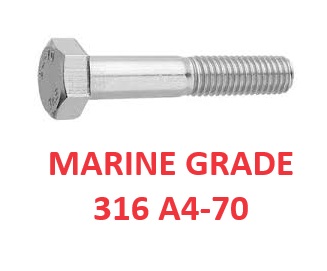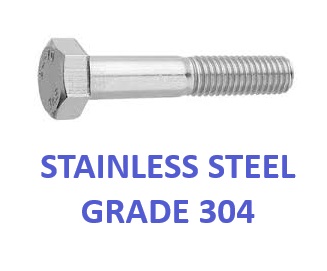Bolts Hex Head Metric Stainless Steel Select Grade
Difference Between Metric Grade 316 Stainless Steel Hex Head Bolts and Metric Grade 304 Stainless Steel Hex Head Bolts (DIN 931)
Overview
Metric grade 316 stainless steel hex head bolts and metric grade 304 stainless steel hex head bolts, both conforming to DIN 931 standards, are commonly used fasteners with distinct properties suited to various applications. Understanding the differences, advantages, and disadvantages of each can help in selecting the right bolt for your specific needs.
Metric Grade 316 Stainless Steel Hex Head Bolts
Advantages:
-
Superior Corrosion Resistance:
- Grade 316 stainless steel bolts are known for their exceptional resistance to corrosion, particularly in harsh environments such as marine and industrial applications.
- This grade contains molybdenum, which enhances its ability to resist pitting and crevice corrosion in chloride environments.
-
High Strength and Durability:
- 316 stainless steel offers excellent mechanical properties, ensuring high tensile strength and durability under various loads.
-
Heat and Chemical Resistance:
- These bolts can withstand higher temperatures and are resistant to a wide range of chemicals, making them suitable for demanding industrial environments.
Disadvantages:
-
Higher Cost:
- The enhanced properties of grade 316 stainless steel come at a higher cost compared to grade 304, which may impact budget considerations for large projects.
-
Slightly Lower Tensile Strength:
- Although 316 has high strength, it is slightly less than that of 304 stainless steel.
Metric Grade 304 Stainless Steel Hex Head Bolts
Advantages:
-
Good Corrosion Resistance:
- Grade 304 stainless steel provides good resistance to corrosion in most environments, including outdoor and mildly corrosive industrial settings.
-
High Strength:
- 304 stainless steel bolts offer high tensile strength, making them suitable for a wide range of applications.
-
Cost-Effective:
- These bolts are more affordable compared to grade 316, providing a cost-effective solution for many projects.
Disadvantages:
-
Lower Corrosion Resistance in Chloride Environments:
- Grade 304 is less resistant to pitting and crevice corrosion in chloride environments, such as coastal areas or chemical plants, compared to grade 316.
-
Limited Chemical Resistance:
- While 304 stainless steel is resistant to many chemicals, it is not as robust as 316 in more aggressive chemical environments.
Summary
Both metric grade 316 and 304 stainless steel hex head bolts conforming to DIN 931 standards are excellent choices for different applications. Grade 316 is preferred for its superior corrosion resistance and durability in harsh environments, while grade 304 offers a cost-effective solution with good strength and corrosion resistance for less demanding conditions. Selecting the right grade depends on the specific requirements of your application, including environmental exposure and budget constraints
Difference Between Metric Grade 316 Stainless Steel Hex Head Bolts and Metric Grade 304 Stainless Steel Hex Head Bolts (DIN 931)
Overview
Metric grade 316 stainless steel hex head bolts and metric grade 304 stainless steel hex head bolts, both conforming to DIN 931 standards, are commonly used fasteners with distinct properties suited to various applications. Understanding the differences, advantages, and disadvantages of each can help in selecting the right bolt for your specific needs.
Metric Grade 316 Stainless Steel Hex Head Bolts
Advantages:
-
Superior Corrosion Resistance:
- Grade 316 stainless steel bolts are known for their exceptional resistance to corrosion, particularly in harsh environments such as marine and industrial applications.
- This grade contains molybdenum, which enhances its ability to resist pitting and crevice corrosion in chloride environments.
-
High Strength and Durability:
- 316 stainless steel offers excellent mechanical properties, ensuring high tensile strength and durability under various loads.
-
Heat and Chemical Resistance:
- These bolts can withstand higher temperatures and are resistant to a wide range of chemicals, making them suitable for demanding industrial environments.
Disadvantages:
-
Higher Cost:
- The enhanced properties of grade 316 stainless steel come at a higher cost compared to grade 304, which may impact budget considerations for large projects.
-
Slightly Lower Tensile Strength:
- Although 316 has high strength, it is slightly less than that of 304 stainless steel.
Metric Grade 304 Stainless Steel Hex Head Bolts
Advantages:
-
Good Corrosion Resistance:
- Grade 304 stainless steel provides good resistance to corrosion in most environments, including outdoor and mildly corrosive industrial settings.
-
High Strength:
- 304 stainless steel bolts offer high tensile strength, making them suitable for a wide range of applications.
-
Cost-Effective:
- These bolts are more affordable compared to grade 316, providing a cost-effective solution for many projects.
Disadvantages:
-
Lower Corrosion Resistance in Chloride Environments:
- Grade 304 is less resistant to pitting and crevice corrosion in chloride environments, such as coastal areas or chemical plants, compared to grade 316.
-
Limited Chemical Resistance:
- While 304 stainless steel is resistant to many chemicals, it is not as robust as 316 in more aggressive chemical environments.
Summary
Both metric grade 316 and 304 stainless steel hex head bolts conforming to DIN 931 standards are excellent choices for different applications. Grade 316 is preferred for its superior corrosion resistance and durability in harsh environments, while grade 304 offers a cost-effective solution with good strength and corrosion resistance for less demanding conditions. Selecting the right grade depends on the specific requirements of your application, including environmental exposure and budget constraints



